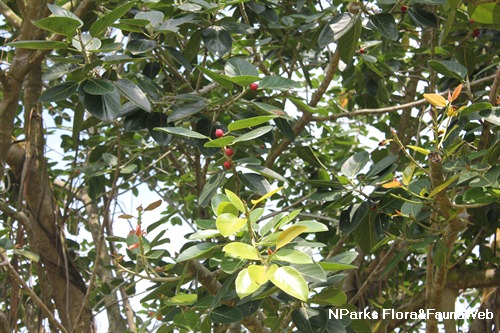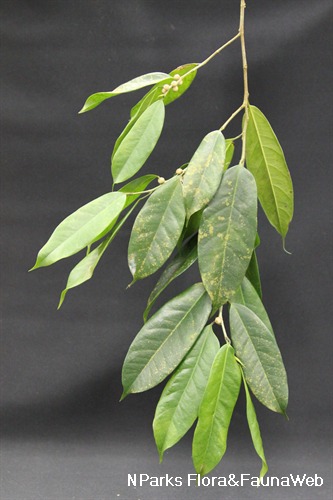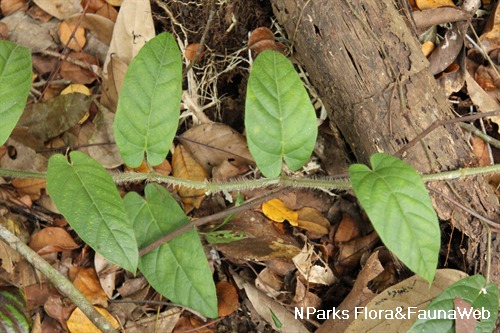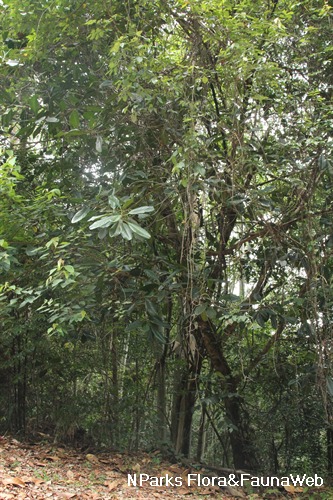
Back
Ficus benghalensis L.
| Family Name: | Moraceae |
| Synonyms: | Ficus banyana |
| Common Name: | Indian Banyan, Banyan Tree, East Indian Fig Tree, Ara Banyan, Bayan |
Name
Classifications and Characteristics
| Plant Division | Angiosperms (Flowering Seed Plants) (Dicotyledon) |
|---|---|
| Plant Growth Form | Tree (Big (>30m)) |
| Lifespan (in Singapore) | Perennial |
| Mode of Nutrition | Autotrophic |
Biogeography
| Native Distribution | India and Pakistan |
|---|---|
| Native Habitat | Terrestrial |
| Preferred Climate Zone | Tropical, Sub-Tropical / Monsoonal |
Description and Ethnobotany
| Growth Form | it is a big tree that grows up to 30 m tall with a wide spreading crown. |
|---|---|
| Trunk | Ficus benghalensis produces aerial roots which turn into woody trunks once they reach the ground. |
| Foliage | Leaves are ovate to elliptic. Both the primary and lateral veins are prominent. |
| Flowers | It is monoecious where both male and female flowers occurs on the same individual. |
| Fruit | Fruits are borne in pairs in the leaf axils. They are globose to depressed-globose, measuring 1-2.5 cm in diameter, and turning red or orange when ripe. |
| Habitat | it is found in tropical forests, up to 1,200 m altitude. |
| Associated Fauna | it is pollinated by fig wasp, Eupristina masoni . |
| Etymology | The genus Ficus, in Latin, refers to the commercial edible fig (Ficus carica). The specific epithet benghalensis is named after the Bengal region. |
| Ethnobotanical Uses | Cultural / Religious: Heritage Trees : There is currently one individual of Ficus benghalensis listed as a Heritage Tree in Singapore. It can be found at Tiong Bahru Park. To find out more about this tree, please visit the Heritage Tree Register. |
Landscaping Features
| Landscaping | This tree is often planted in gardens and along streets. In India, this tree is sacred to Hindus and Buddhists, usually planted around temples. |
|---|---|
| Desirable Plant Features | Ornamental Fruits, Ornamental Form |
| Landscape Uses | Parks & Gardens, Shade Providing Tree / Palm |
| Usage Hazard - Cons | Irritant - Sap |
Fauna, Pollination and Dispersal
| Fauna Pollination Dispersal Associated Fauna | Bird-Attracting (Fruits) |
|---|---|
| Pollination Method(s) | Biotic (Fauna) (Insects (Ant, Beetle, Fly, Thrip, Wasp), Associated with: Eupristina masoni) |
| Seed or Spore Dispersal | Biotic (Fauna) |
Plant Care and Propagation
| Light Preference | Full Sun |
|---|---|
| Water Preference | Moderate Water |
| Plant Growth Rate | Moderate |
| Rootzone Tolerance | Drought Tolerant, Moist Soils, Well-Drained Soils, Fertile Loamy Soils |
| Propagation Method | Seed, Stem Cutting |
Foliar
| Foliage Retention | Evergreen |
|---|---|
| Mature Foliage Colour(s) | Green |
| Mature Foliage Texture(s) | Leathery |
| Foliar Type | Simple / Unifoliate |
| Leaf Area Index (LAI) for Green Plot Ratio | 3.0 (Tree - Intermediate Canopy) |
Floral (Angiosperm)
| Flower & Plant Sexuality | Unisexual Flowers |
Fruit, Seed and Spore
| Mature Fruit Colour(s) | Orange, Red |
|---|
Image Repository
Others
| Master ID | 1606 |
|---|---|
| Species ID | 2899 |
| Flora Disclaimer | The information in this website has been compiled from reliable sources, such as reference works on medicinal plants. It is not a substitute for medical advice or treatment and NParks does not purport to provide any medical advice. Readers should always consult his/her physician before using or consuming a plant for medicinal purposes. |











.jpg)